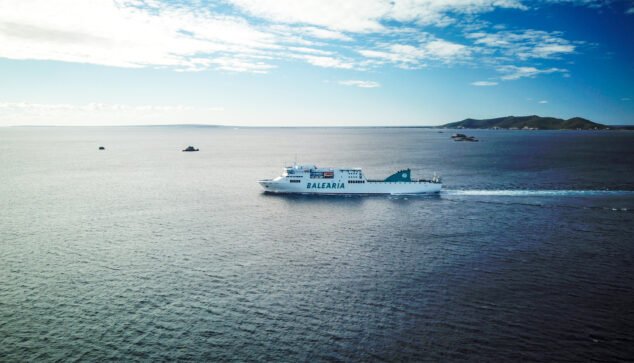Baleària It already has a sixth ship in its fleet ready to sail powered by natural gas, after the completion this week of the re-engine of the Sicilia ferry, the fourth operation of this type carried out by the shipping company in recent years. The retrofit has been carried out at the West Sea shipyard in Viana do Castelo (Portugal). The ship is scheduled to operate on the Barcelona-Ibiza line powered by this much cleaner fuel.
The work to adapt the engines of the Sicilia began at the end of February, and ended this Tuesday, after successfully completing the sea trials. A tank with a capacity to store 425 cubic meters of LNG has been installed on the ship, something that will allow it to have a range of 1.100 nautical miles. In addition, the MAN9L48 / 60 engines have been adapted to the 9L51 / 60DF version, which allow both gas, fuel or diesel navigation.
In addition, this is the second ship of the shipping company in which a series of sensors have been installed that will allow monitoring the fuel consumption and emissions of the ship in real time. Thus, the Sicilia and the Bahama Mama are the first two vessels to include this system in the fleet of Baleària, which is part of a European consortium that participates in the European Green and Connected Ports project, subsidized at 50% of the cost by CEF Transport funds. For Baleària It is the first phase of the project for a future fleet control tower that will allow operations and ships to be managed more efficiently from different aspects, such as safety, preventive maintenance of equipment and commercial efficiency. In 2022, five ships in the fleet will have this monitoring.
'Smart ship' technology
In the same way as the other ships that have already been remotorized, various technological improvements were made on the Sicilia to turn it into a smart ship. On the ship, passengers will be able to have WhatsApp text during the voyages, in addition to Wi-Fi connection and also access to the on-demand digital entertainment platform, among other improvements.
The 186-meter-long ship has a capacity for about 1.000 people and 480 vehicles. It has several accommodations, such as an armchair, upper armchair and cabins, as well as different services such as a shop, bar, restaurant, cafeteria, an area for children's entertainment and an area for pets, among others.
First fast ferry with gas engines
On the other hand, the construction of the ship Eleanor Roosevelt de Baleària, which will be the world's first fast ferry with engines that consume natural gas, continues to advance at the Armon shipyard in Gijón. It is a pioneering project with a high technological content, whose construction process is currently at 80%. Specifically, the work on the hull and the engines is practically finished and the part of fitting out the ship has already begun, with the laying of the pipes and electrical installations. In addition, part of the seats and other interior spaces have also been manufactured. This ship, which will be a pioneer worldwide in terms of technology and dimensions, will have a length of 123 meters and a beam of 28. It will have a capacity for 1.200 passengers and a warehouse that can hold up to 500 linear meters of cargo and 250 cars, or alternatively 450 cars.
Bet on natural gas
Natural gas is a fuel that reduces CO30 emissions by 2%, NOx emissions by 85%, and eliminates sulfur and particles that are harmful to health. Baleària has been betting on this source of energy as fuel for its ships since 2012, and for now it already has, in addition to Sicilia, another five sailing on LNG: the remotorized Bahama Mama, Naples and Abel Matutes and the newly built Hypatia de Alejandría and Marie Curie. In addition, it is building the aforementioned Eleanor Roosevelt and plans to retrofit two other ships in the fleet: the Hedy Lamarr, and the Martin i Soler. It should be remembered that the remotorization operations are part of the LNGHIVE2 Green & Smart Links project, co-financed by the CEF Blending program of the European Commission.







